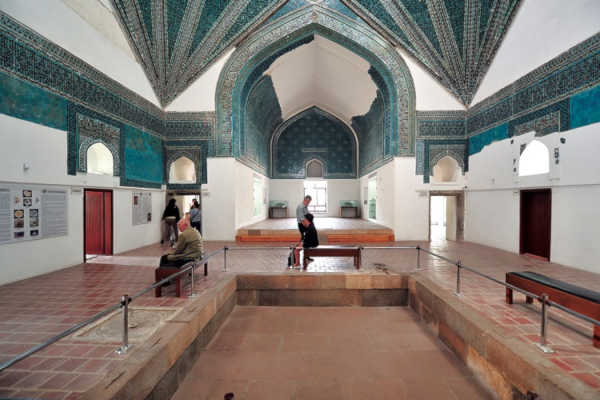Explore Karatay Madrasa in Konya, Turkey
Knowing how to ask questions is the first step
toward wisdom, according to an inscription on the Karatay Madrasa's entrance.
This exemplifies the importance the Seljukians placed on knowledge and science.
Millions of people were pushed to migrate to Anatolia from Central Asia and
Khorasan because of the Mongols' domino effect. The Turkish desert included several
prominent scholars. To create a metropolis of knowledge and education like
Samarkand or Bukhara, Seljukians welcomed many of them to their capital city
Konya. Various education facilities were funded by emperors, politicians,
members of the public, and distinguished members of society in Konya and other
significant imperial towns. During the 12th and 13th centuries, cities along
major trade routes like the Silk and Spice Roads flourished. The beautiful
tiles that decorate the domes of the Karatay Madrasa set it apart from the
others. These priceless items were discovered during excavations in the
Seljukian Palace on Lake Beysehir, close to Konya. The Karatay Madrasa, which
was constructed in 1251 by the Grand Vizier Celaleddin Karatay during the rule of
Sultan II Kaykaus, served as a theological college until the end of the 19th
century. The building was transformed into a museum in 1955 and was still being
maintained in 2006 by the Republic of Turkey's Ministry of Culture and Tourism.
If you are looking for the best escape, apply for a turkey visa online and visit
Karatay Madrasa once in a lifetime.
Where is Karatay Madrasa?
The Karatay Madrasa is in Konya. The vast flat
plains surrounding Konya are regarded as the Republic of Turkey's breadbasket.
Nearly in the centre of our nation, Konya is barely three hours from
Cappadocia. Every day, many direct flights connect Istanbul with Konya. In
addition, a fast train takes just two hours to travel from Ankara to Konya.
Many self-driving tourists in Turkey should stop at Konya for one night to rest
before continuing from Cappadocia to the West Coast or Mediterranean area. The
stunning Seljukian monuments of Konya city can be easily visited by reserving a
hotel in the city's heart. Alaaddin Hill, which is situated the opposite way
from Mevlana's Dervish Lodge, is very close to Karatay Madrasa. You can start
your Konya trip from Karatay Madrasa on foot and take a taxi from any central
location hotel in Konya. Locations of Alaaddin Hill, Alaaddin Mosque, and Ince
Minare Madrasa are all located on & around Alaaddin Hill. You may finish a
fantastic Konya city tour and get to the Museum of Mevlana by walking for ten
minutes from Alaaddin Hill. Thanks to their parking facilities, one should
begin their city trip from either the Mevlana Museum or the Karatay Madrasa.
The Mevlana Museum is only 1.2 kilometres from Karatay Madrasa, and the
distance between them can be covered on foot in 15 minutes.
What to see in Karatay Madrasa?
The Karatay Madrasa itself is a superb example of
Seljukian construction. By choosing not to sign this masterpiece, which is
usual in Seljukian architecture, the architect displayed exceptional modesty.
Even though Celaleddin Karatay passed away in Kayseri city, we know he provided
funding for the project. His body was brought to Karatay Madrasa and buried
beneath one of the mosque's four small domes. Ottoman and Seljuk madrasas were
designed with an interior court typically used for astronomy classes. The
massive dome that covers Karatay Madrasa's centre court must be a result of
Konya's severe winters. A pool is in the centre, and terra cotta pipes may be
seen under the glass installed during the 2006 renovations that brought the
water there. Fantastic blue tiles cover the dome and the western barrel vault
in great numbers. The antiques discovered at the Kubadabad Palace in Konya's
Beysehir city and the original tiles from the Karatay Madrasa are now on
display inside the museum.
Who is Celaleddin Karatay?
Celaleddin Karatay, a renowned politician, led the
Anatolian Seljuks. Although many historians claim that he was of Turkish
origin, he entered politics after receiving his education at the Anatolian
Seljuks' Gulamhane. The majority of students at Gulamhane are enslaved people
who are being educated and groomed to work as royal guards or officials. In
Arabic, the word "gulam" denotes a young boy. He was most likely
enslaved during I Kaykhusraw's Armenian Campaign somewhere between the
Anatolian districts of Cilicia and Cappadocia. After his education, he worked
as the council's scribe, Sultan's maid, and a personal wealth accountant. While
the Seljukian Sultan was away from the palace, he continued to serve as his
assignee and as his accountant until Sultan's death in Kayseri. He founded
several buildings throughout the Anatolian Seljukian domains, including Karatay
Madrasa.
We offer turkey
visa online to Turkey for your desired tour, from romantic honeymoons
to scenic self-drive road trips to significant destinations.






Comments
Post a Comment